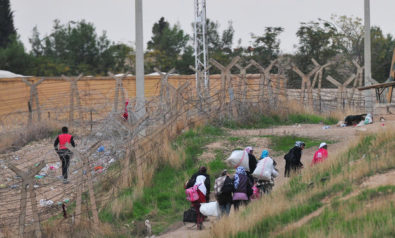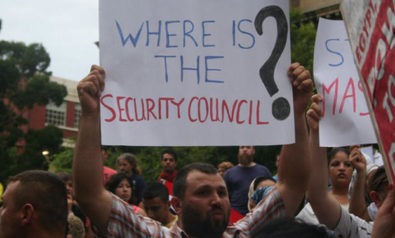The success of Kofi Annan’s mediatory efforts in Syria is far from guaranteed, and cooperation by both the regime and the rebels is essential if Syria is to return to stability.
Easter Sunday seemed to mark a resurrection of sorts in Syria – a resurrection of the fang-baring, take-no-prisoners ferocity that has dominated the Syrian government’s response to opponents, whether peaceful or armed. As fighting intensifies on the eve of the declared deadline for troop withdrawals and a ceasefire, it is international mediator Kofi Annan’s proposed peace process that many see at risk of burial.
President Bashar al-Assad assured Annan that his security forces would dial back the violence and withdraw from populated areas ahead of the April 10 deadline fixed by the United Nations Security Council, but the weekend escalation in attacks by those forces was so intense that Annan publicly denounced the situation as “unacceptable.” And “take-no-prisoners” proved more than a metaphor, as Human Rights Watch released a report documenting over a hundred summary executions by security forces in recent weeks.
A last-minute surge in violence just before a ceasefire, as adversaries scheme to secure one last shred of advantage before fighting stops, is not unheard of in these kinds of situations. But on Sunday the government went further, abruptly demanding that Annan produce “written guarantees” from “armed terrorist groups” that they would end their violence.
Rebel leaders charged perfidy. “The regime will not implement this plan,” declared the chief of the Free Syrian Army. “We have given our word that if the regime commits to the plan then we will too.”
Another spokesman for rebel forces underscored even more emphatically their commitment to Annan’s plan: “We will commit to the deadline even if they [government forces] do not pull back, we will cease fire as we have pledged to the UN. But if they fire we will pick up arms again and fight them.”
Curiously, Annan himself said nothing about the government’s seeming new precondition—waiting to see, perhaps, if it may prove to be a bluff. After all, the Baathist regime is in a far more difficult position, internally and internationally, than it was when it pulled the rug out from under Arab League mediation efforts late last year.
Damascus then could count on a fair amount of sympathy from the many countries still irate about the Western military intervention to overthrow Moammar Qaddafi in Libya’s civil war. Russia and China, in particular, vetoed proposed Security Council measures directed at the Syrian government in October and again in February.
Both countries tolerated the redoubled efforts of Assad’s forces to stamp out the rebellion once and for all since the February council vote. But far from dealing a knockout blow to the rebellion, the result appears to have been the relocation of opposition fighters to other venues, like squeezing a water balloon.
The massive shelling of entire city neighborhoods—eerily documented by Syrian state television in recording a visit by Assad himself to a ruined Homs—had rebels reeling but not surrendering. The Russians in particular must be aware that a Chechnya-style military campaign cannot restore Assad’s authority over Syria. And they have become as alarmed as the West, by signs of Al Qaeda interest in the Syrian meltdown.
As Syria has moved steadily to the brink, Russia and China have become deeply invested in the success of Annan’s mission. China today warned “the Syrian government and opposition groups to seize the current critical moment to abide by cease-fire and troop withdrawal promises.” Russia too insists that “violence must be stopped” and worries that a deepening civil war may spin out of control, as did those in Lebanon and Somalia in past decades. The prospect that a heterogeneous Syria could become a perilously ungovernable space for a very long time unnerves policymakers in both countries.
The United States and Western countries have noticeably cooled their rhetoric demanding Assad’s ouster, trying to create more space for Annan’s efforts to succeed. Russia and China are supposed to be doing their part by delivering Assad to the troop pullbacks Tuesday and the ceasefire Thursday. And Annan is to visit Iran on Wednesday, in hopes it too will have persuasive power with the Syrian security establishment.
Of course, much could go wrong over the next three days. If Damascus does not pull back its troops Tuesday or honor the 6 a.m. ceasefire Thursday, the Russians and Chinese should be expected to come to the Security Council with some proposed measures to help the recalcitrant regime confront reality. In that circumstance, a prompt suspension of all arms transfers into Syria—including Saudi and Qatari support for favored rebels–could provide just the jolt needed.
Perhaps, like other ceasefires in other conflicts where one side or another persists in thinking it can still achieve victory, it will take a second try. This is not the moment to despair of the Annan peace initiative. It is the only option around for managing Syria’s passage from its current bloody impasse with some hope of a stable and sustainable settlement.
*[This article first appeared in the Huffington Post.]
The views expressed in this article are the author’s own and do not necessarily reflect Fair Observer’s editorial policy.
Support Fair Observer
We rely on your support for our independence, diversity and quality.
For more than 10 years, Fair Observer has been free, fair and independent. No billionaire owns us, no advertisers control us. We are a reader-supported nonprofit. Unlike many other publications, we keep our content free for readers regardless of where they live or whether they can afford to pay. We have no paywalls and no ads.
In the post-truth era of fake news, echo chambers and filter bubbles, we publish a plurality of perspectives from around the world. Anyone can publish with us, but everyone goes through a rigorous editorial process. So, you get fact-checked, well-reasoned content instead of noise.
We publish 2,500+ voices from 90+ countries. We also conduct education and training programs
on subjects ranging from digital media and journalism to writing and critical thinking. This
doesn’t come cheap. Servers, editors, trainers and web developers cost
money.
Please consider supporting us on a regular basis as a recurring donor or a
sustaining member.
Will you support FO’s journalism?
We rely on your support for our independence, diversity and quality.










































Comment